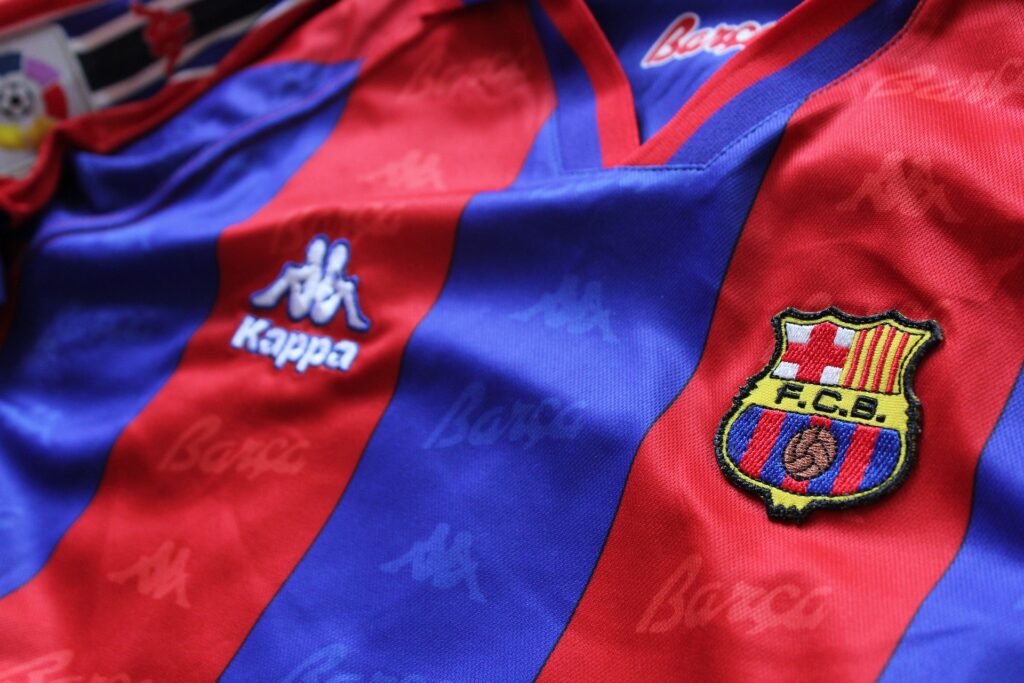The FC Barcelona Logo, History, Vibrant Colors, Wallpapers

Contents
With an indelible mark on the landscape of global sport, FC Barcelona is synonymous with excellence in football. Besides the mesmerizing plays and championship victories, the FC Barcelona logo symbolizes the heart and soul of the club. This article will explore the history of the FC Barcelona logo, its cultural significance, and its profound influence on sports and beyond.
The FC Barcelona logo has evolved along with the club’s remarkable journey from modest beginnings to sporting superstardom. Let’s examine the visual story behind the FC Barcelona logo, a symbol that transcends sports and has become an icon for supporters.

The legacy of a Sporting Icon
With a rich history filled with remarkable achievements, FC Barcelona stands as a testament to excellence sporting icon. Founded in 1899, the club has consistently demonstrated outstanding football talent, leading to a storied history.
Known affectionately as the Blaugrana, they’ve won a bunch of domestic and international titles, including La Liga, Copa del Rey, and UEFA Champions League. Their success isn’t just measured in trophies but also in the mesmerizing style of play they use–Tiki-Taka.
The legacy of Barcelona goes beyond their brilliance on the field. In addition to their commitment to social causes, the club’s inclusivity and unwavering support for Catalan culture have made them more than a football club.
The Birth of the FC Barcelona Logo
The FC Barcelona logo, a symbol of a timeless sporting icon, was not always the iconic logo we know today. Likewise, it has a rich and storied beginning, just like the club itself.
FC Barcelona was founded in 1899 by a group of football enthusiasts led by Swiss sportsman Hans Gamper. The original Barcelona logo consisted of a heraldic rhombus surrounded by a green wreath, topped by a gold crown with a black bat spreading its wings. The rhombus had a background of red, yellow, and white geometric patterns divided into four segments. The upper left and lower right segments had a red cross on a white background, while the upper right and lower left had red and yellow vertical stripes.
1899-1910

As the club gained prominence, the need for a more distinctive logo became evident. In 1910, the first semblance of the club’s modern logo was created, with blue and scarlet colors, which became known as “Blaugrana.” It featured an interwoven letter “FCB,” reflecting FC Barcelona’s foundation as a fusion of different football clubs.
The evolution of the club’s identity and logo closely parallels the historical and cultural shifts in Catalonia. In addition to reflecting the club’s deep connection to the region, the logo also represents the club’s ever-evolving identity as a global football powerhouse.
Evolution of the FC Barcelona Logo
The FC Barcelona logo has undergone a dramatic transformation, mirroring its growth, accomplishments, and shifting cultural dynamics over the years. The evolution of this logo is not just about design changes; it’s a reflection of the club’s historical and cultural significance.
- Early Designs: The club’s early logo featured the intertwined letters “FCB” in the club’s signature blue and scarlet colors. These colors, often referred to as “Blaugrana,” played a significant role in defining the club’s identity. Using this simple design in the club’s early days laid the foundation for an international sporting icon.

- 1920s – 1930s: FC Barcelona became more prominent in the Spanish football scene, and the logo evolved accordingly. The Blaugrana colors became more dominant during this period, and the letters “FCB” were creatively incorporated into a circular design. With this shift, the club began to rise in the Spanish football hierarchy.

- 1950s – 1960s: In the mid-20th century, the logo experienced further changes, with cleaner lines and a more stylized appearance. With the Catalan flag on the left and the St. George’s Cross on the right, the club’s crest gradually took shape, with the FCB initials at the center. FC Barcelona was growing in prominence on the national stage during this time and laying the foundation for its international success.

- 1970s – 1990s: In the following decades, the logo underwent small changes, mainly to refine its design. The logo remains instantly recognizable despite these changes and represents Catalonia’s pride in football.

- The Modern Era: The FC Barcelona logo was most recently transformed in the early 2000s. This version is a blend of tradition and modernity. In addition to the Blaugrana colors, FCB initials, Catalan flag, and St. George’s Cross, the new logo retains the club’s core identity. It represents both the club’s forward-looking approach to football and its cultural significance with a sleeker and more contemporary design.
The FC Barcelona logo represents not just the club’s evolution but also its identity, values, and global impact.
The Current FC Barcelona Logo
FC Barcelona’s current logo is a harmonious blend of tradition and modernity, representing both the club’s storied history and its progressive future. With its distinct design elements, this logo carries tradition while staying relevant to the modern game.
The key design elements of the current logo include:
- FC Barcelona Colors: The FC Barcelona colors are blue and red. The club’s primary colors are blue and garnet (a shade of red), and their home kit typically features vertical blue and red stripes. The FC Barcelona colors have become iconic for the club, and they are often referred to as the “Blaugrana”, a combination of the Catalan words for blue (“blau”) and garnet (“grana”). The colors are also prominently featured on the team’s crest, and are a symbol of the club’s rich history and tradition.

- ‘FCB’ Initials: The intertwined letters “FCB” are positioned at the center of the logo, a nod to the club’s official name, Futbol Club Barcelona. The design element is a direct reference to the club’s earliest logos, highlighting the continuity of its history.
- Catalan Flag: The Catalan flag, also known as the Senyera, adorns the left side of the logo. This element reinforces the club’s strong association with Catalan culture and identity.
- George’s Cross: The St. George’s Cross is displayed on the right side, which is also part of the Catalan flag. This inclusion pays homage to the club’s English roots and its founder, Hans Gamper, who was from Switzerland.
- Modern Styling: While the core elements of the logo stay the same, the design is sleeker and more contemporary. Modern design represents FC Barcelona’s commitment to remain competitive in an ever-evolving sport.
From humble beginnings to a global football giant, the logo represents the spirit of innovation, unity, and excellence that defines the club.
Cultural Impact
The FC Barcelona logo transcends sports and resonates with communities and cultures around the world. The cultural impact of the logo is multifaceted and wide-ranging, including:
Catalan Identity
The FC Barcelona logo proudly incorporates the Senyera, the flag of Catalonia, reflecting the club’s close association with the region. The club symbolizes more than just football for Catalans; it’s a source of pride and unity.
Global Recognition
FC Barcelona’s logo is recognized worldwide. It has become a universal symbol of excellence, with fans and admirers in every corner of the globe. The Blaugrana colors are instantly associated with the club, making it one of the most iconic sporting logos.
Merchandising and Branding
The logo’s popularity extends to a vast array of merchandise, from jerseys and scarves to mugs and memorabilia. As a club with a significant commercial presence, FC Barcelona’s logo plays a central role in its marketing efforts.
Fan Culture
The logo is the focal point of fan culture, both in Catalonia and among international supporters. It is proudly displayed in stadiums, on FC Barcelona wallpapers, and in fan art. The passion and devotion of Barça supporters are reflected in their commitment to the logo and what it represents.
FC Barcelona Wallpapers

The popularity of FC Barcelona wallpapers in fan culture can be attributed to several key factors. In today’s digital age, where smartphones, tablets and laptops are ubiquitous, fans take the opportunity to personalize their devices with Blaugrana pride. The variety of wallpapers available is staggering and caters to every fan’s taste, from classic club emblems to artistic interpretations of beloved players like Messi and Iniesta. These wallpapers not only celebrate the club’s rich history and iconic victories, but also pay homage to legendary players who’ve left a lasting mark on FC Barcelona.
Download FC BARCELONA WALLPAPERS
Social Initiatives
The logo represents FC Barcelona’s commitment to social causes and its belief in inclusivity and diversity. The club’s motto, “Més que un club” (More than a club), reflects its dedication to making a positive impact beyond the realm of football.
FC Barcelona purple jersey

The symbolic meaning of the FC Barcelona purple jersey is as follows. FC Barcelona has introduced a new initiative to commemorate International Women’s Day by incorporating the color purple. The announcement was emphasizing the club’s unwavering commitment to diversity, equality, and inclusion, as outlined in the Club’s Statute. In alignment with these values, the club has launched various initiatives aimed at emphasizing the significance of highlighting women in the world of sports.
To bring this concept to life, Barça has partnered with Pantone, a renowned color-mixing company, to create a distinct hue known as “Lila Barça.” This new color, symbolizing equality, is derived from blending the club’s original colors of blue and maroon.
This move seeks to enhance awareness and recognition of International Women’s Day, celebrated on March 8th.
Influence on Art and Design
The logo’s aesthetics have influenced art and design, from street art to fashion. In the creative world, its visual appeal has left an indelible mark, inspiring artists and designers.
In addition to being a symbol, the FC Barcelona logo also represents a cultural phenomenon. It unites people, transcending language and geographical barriers. In addition to its impact on sports fans, it touches the hearts and minds of the people who admire the club’s values, history, and emblem.
FAQs
Why does the FC Barcelona logo include the Catalan flag and St. George’s Cross?
The inclusion of the Catalan flag, or Senyera, on the left side of the logo and the St. George’s Cross on the right side, reflects the club’s historical and cultural roots. The Senyera represents the Catalan identity, while the St. George’s Cross is a tribute to the club’s founder, Hans Gamper, who was from Switzerland.
How has the FC Barcelona logo evolved over the years?
The FC Barcelona logo has undergone several transformations since the club’s inception in 1899. It has evolved from a basic design featuring intertwined letters to a more stylized logo that retains the core elements of the Blaugrana colors, ‘FCB’ initials, and the Catalan and Swiss flags. The current logo is a blend of tradition and modernity, emphasizing the club’s heritage and its commitment to staying relevant.
What is the significance of the ‘FCB’ initials in the logo?
The intertwined ‘FCB’ initials in the logo represent the club’s official name, Futbol Club Barcelona. This design element is a direct link to the earliest versions of the emblem, emphasizing the club’s historical continuity and identity.
Why is FC Barcelona often referred to as “More than a club”?
“Més que un club” (More than a club) reflects FC Barcelona’s commitment to social causes, inclusivity, and making a positive impact beyond football. The club has consistently supported charitable initiatives and emphasized its role as a unifying force in the Catalan community.
The Takeaway
As a symbol of excellence and cultural significance, FC Barcelona’s logo is steeped in history. The evolution of its design mirrors the club’s journey from local success to global recognition. In addition to being a football symbol, it transcends boundaries and influences art, design, and fan culture.
Explore the history of the Warner Bros. logo

As our Chief SEO & Branding Strategist, Robert Ellison is a digital marketing visionary with over 25 years of experience transforming brands through smart, data-driven SEO and impactful storytelling. Known for his expertise in aligning technical SEO with authentic brand narratives, he leads our team in creating strategies that boost search rankings while building strong, sustainable brand identities. A trusted advisor and frequent industry speaker, Robert combines deep technical knowledge with creative insight, helping our clients not only reach the top of search results but also genuinely connect with their audiences.
